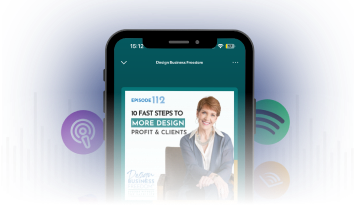Time Management for Interior Designers: Get More Done
Time management for interior designers can be distilled to a single simple 3-step practice that keeps you on track every day and having a wildly productive week, every week. It isn’t complicated, it is a new habit that you’ll want to implement. The tricky bit about habits is that they take 21 days to form, and only 7 days to break. Are you ready to step up and reclaim your business and life from the jaws of overwhelm and perpetually playing catch up? Let’s dive in.

Time Management for Interior Designers
Step 1 ~ Keep a Time Diary for 2 Weeks
To ensure great time management for interior designers, you need to know where your time is going in the first place. And while this step is tedious, it is also eye opening. I’ve worked with designers who just got this far and were shocked by what they discovered about their time use (and abuse) habits.
Get a journal or one of the old fashioned green ledger notebooks at your local office supply or Amazon. Across the top of each page put down each day of the week. I recommend that you include the weekends as most of us spend at least an hour and sometimes a lot more either catching up on loose ends and/or planning for the week ahead on Saturday or Sunday.
Down the left column record time increments in 15-30 minutes from the time you wake up to the time you go to bed. (Yes, you will see how much time you spend with TV, eating, errands, and social media, that’s the point.)
For two weeks record all of your activities whether it’s eating breakfast, taking the kids to school, meeting a client, sourcing fabric, attending an event, installing a project, bookkeeping, fixing dinner, scheduling your assistant, watching TV, listening to a podcast or taking the dog for a walk. Literally everything you do (and I know there’s a ton) shows up in the diary.
The more vigilant you are in keeping an accurate diary, the more intelligence you’ll have about your time habits and where you’re going down rabbit holes, getting distracted, and wasting time. This step is critical to implement effective time management for interior designers.
Step 2 ~ Assess Your Findings
Just keeping the diary isn’t useful, you’ve got to assess your findings. In fact, it’s often far more effective to share this with a coach, consultant, or mentor and invite their expert insights and feedback. In many cases, the designers I coach are able to recover as much as 10 hours a week previously lost to non-productive activities and time sucking black holes in their business. And this is the first step in coaching because it’s tough to grow your practice when you aren’t in control of your time and feel run over much of the time.
Step 3 ~ Implement Time Blocking
Time blocking is without fail the simplest and fastest method of time management for interior designers. It doesn’t require any software, no fancy tools, just your willingness to look at a week or longer at a time and block every activity in your business on your calendar. Start with framing the hours you want to work each day so you have a clear parameter to work inside of instead of allowing your work to run into the night or force very early mornings.
Next, set yourself up for time management success by specifying specific activities for specific days of the week. Don’t worry we aren’t setting a boring routine, we are managing your time for optimal productivity the key to time management for interior designers. For example, in my practice, Monday is my office day, Tuesday and Thursday are client meeting days and sourcing. Wednesday is blocked for installations and Friday is left open to cover additional sourcing, a last minute client call, project management and paperwork. That means my weekend is free because I create next week’s calendar on Friday afternoon.
It’s going to take you a couple of weeks to get into this kind of a routine. It is worth it because it puts you squarely in charge of your business, instead of allowing it (and your clients) to run you. And you avoid the myth of multi-tasking being a good thing. In fact multi-tasking is costing you huge losses in productivity. Every time you switch tasks you expend an additional 30% of your time and brainpower refocusing (this is science, not imagined.) Multi-tasking is nothing to brag about!

Time won’t run out when you use Time Blocking to manage your time.
Once you’ve nailed down the specific days of the week, fill in your calendar with client appointments, sourcing blocks of time, events that you want to attend, and be sure to get specific in blocking for project management and admin. You want to block time for purchase orders, for bookkeeping, for your weekly client follow up, for space planning for each project, for mood boards, for networking, for workouts, for lunch, for design events, for every thing you do.
For a simple example of time blocking, go to my exclusive designer FB group where we grow your business. It’s free and loaded with powerful tools and systems to give you more time to design and less to be overwhelmed by.
Take a look and see if you don’t think you don’t get more done, ditch the distractions and have more time for life beyond work. You can book as much as a month at at time when you have a full client roster. Start with their deadlines of installation and work backwards. And, of course you can block 2 day installations or show your team at work while you are on another task. The colors make it easy to see what you’re doing. This is Google Calendar, free, nothing fancy.
Time blocking ROCKS! (Go to the group and join HERE to see exactly how simple it is.) The time you’ll save by knowing, in advance, precisely what needs to get done and having a deadline (time block) to work against will inspire you and give you more creative brain space to take your designs to the next level. (And I’m in the group everyday providing tips, strategy, support and guidance to move you forward.)
Grab your FREE copy of “20 Time Management Tips for the Trade” just click HERE.
Follow me on social media @melissagalt on Instagram, Twitter, and Facebook for the latest strategies, tips, and tools to keep you earning more in less time with clients who absolutely love you!
Great time management for interior designers becomes a major creative win for your business giving you more time for what you love and still taking care of all of the other pieces until you have a team in place to delegate those other pieces to. Stay tuned for an upcoming article in how to know what to delegate and how to make the right hire the first time!





